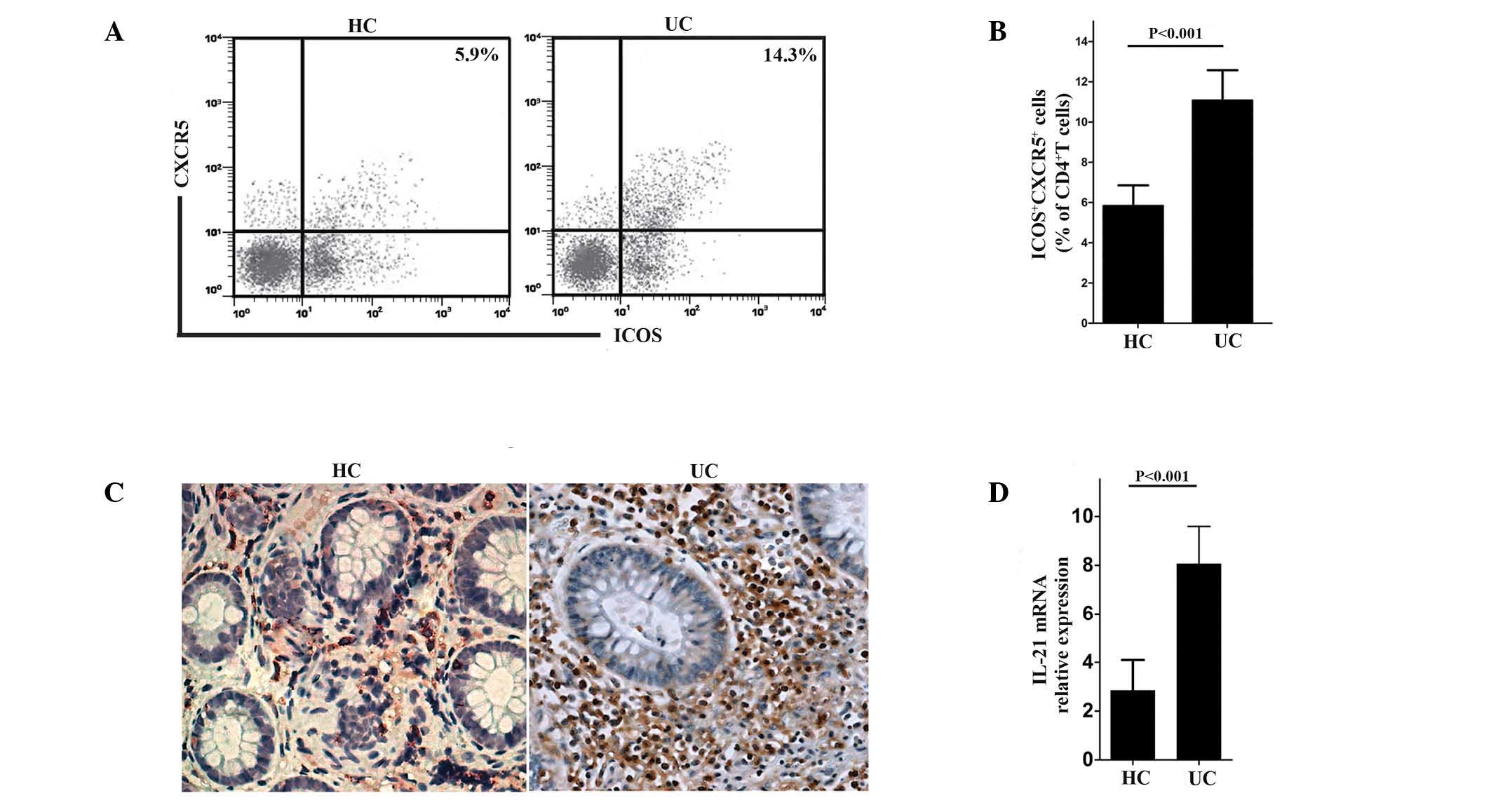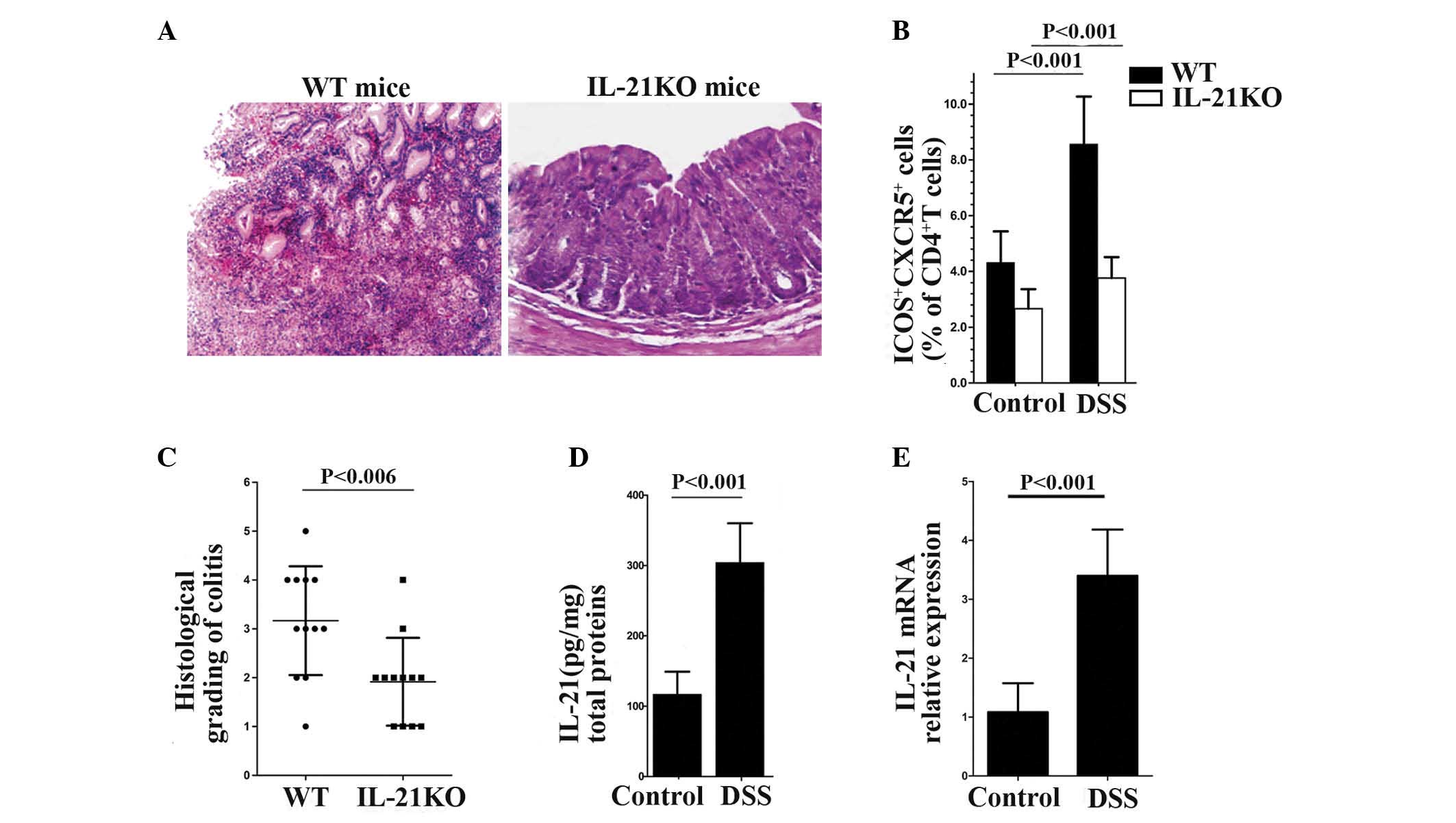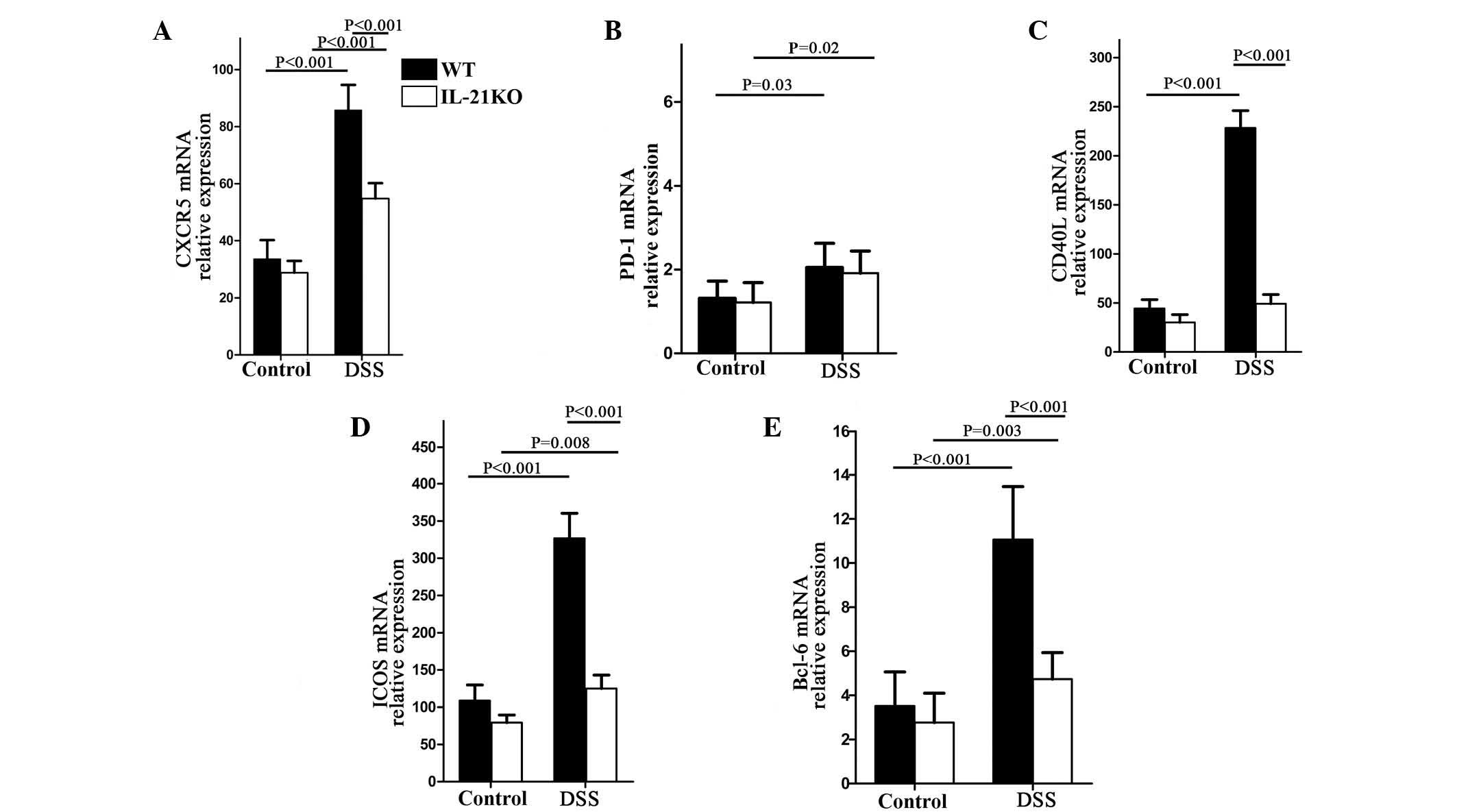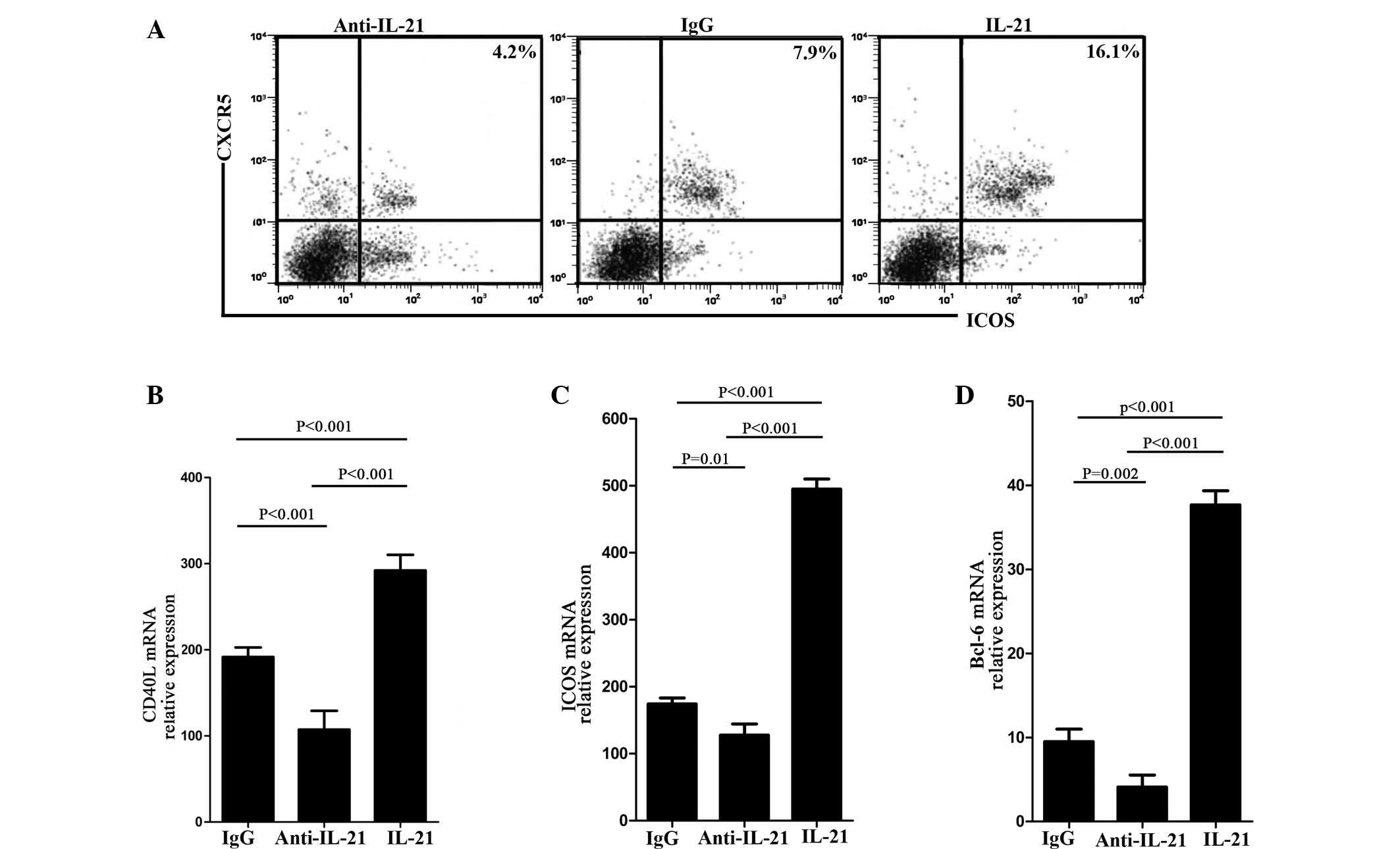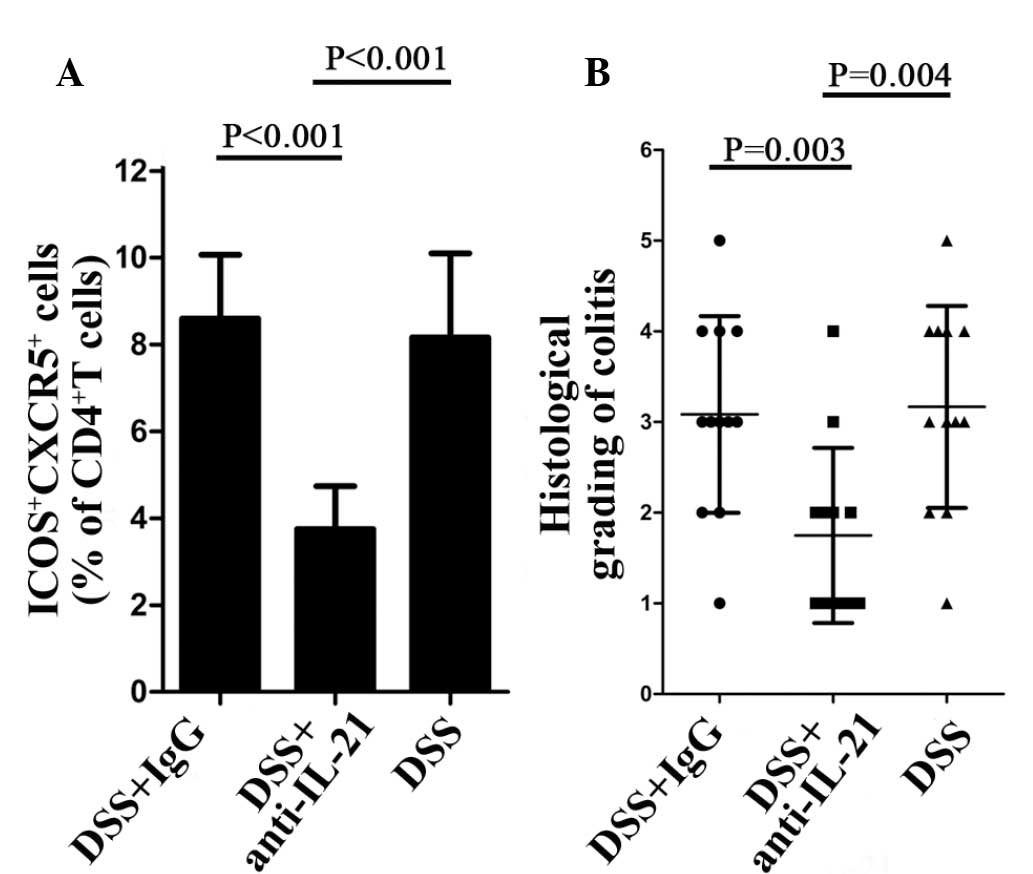Interleukin‑21 promotes the development of ulcerative colitis and regulates the proliferation and secretion of follicular T helper cells in the colitides microenvironment
- Authors:
- Published online on: October 30, 2014 https://doi.org/10.3892/mmr.2014.2824
- Pages: 1049-1056
Abstract
Introduction
Chronic inflammation is a major driving force in the initiation and progression of various types of tumor in numerous tissues (1). Ulcerative colitis (UC) is one of the major forms of chronic inflammatory bowel diseases in humans. Patients with UC have an increased risk of developing colitis-associated colon cancer (CAC) and the level of risk is associated with the extent and duration of the disease and the severity of microscopic inflammation (2). There are different opinions regarding the mechanisms underlying UC (3–5). Immune cells, including T helper (Th)1, Th17 and follicular T helper (Tfh) cells, infiltrate the nidus producing cytokines, which is considered to be important in the progression of inflammation.
Tfh cells, which are located in germinal centers (GC), have emerged as a separate subset of cluster of differentiation 4 (CD4)+ T helper cells that express high levels of inducible costimulator (ICOS), C-X-C chemokine receptor type 5 (CXCR5), CD40 ligand (CD40L), programmed cell death-1 (PD-1) and the important transcription factor B-cell lymphoma 6 (Bcl-6) (6,7). Interleukin (IL)-21 is a pleiotropic cytokine synthesized by Tfh cells and is also expressed by other CD4+ T cells, including Th1, Th17 and activated natural killer T cells (8–10). IL-21 modulates innate and adaptive immune responses (11). Furthermore, IL-21 is crucial in the proliferation of T cells, B cells and natural killer cells, and affects regulatory T cells (12). IL-21 performs functions through a heterodimeric receptor, IL-21 receptor (IL-21R), which is highly expressed by CD4+ T cells (13,14). Studies have indicated that IL-21 controls the functional activity of epithelial cells and fibroblasts in the gut, thus it is an important mediator in the crosstalk between immune and nonimmune cells (15,16). The present study examined whether Tfh cells and IL-21 are necessary for the development of chemically-induced colitides and examined their interconnections in UC.
Materials and methods
Patients
Colonic tissue sections were obtained from patients comprising 20 cases of UC and 15 healthy controls, the latter suffering from non-UC inflammatory diseases, including colonic ileus and vascular malformation. The diagnosis of UC was determined according to established guidelines based on endoscopic and histopathological examination. Each sample was divided into two sections. One section was used for histopathological analysis, in which the sample was deparaffinized, dehydrated through xylene and ethanol and incubated with a rabbit anti-human polyclonal IL-21 antibody (R&D Systems, Minneapolis, MN, USA) for 2 h at room temperature. It was then counterstained with hematoxylin (Sangon Biotech, Shanghai, China). The other section was frozen in liquid nitrogen and stored at −80°C until Tfh cell and IL-21 RNA analysis. All the samples were collected at the Department of General Surgery, The First Affiliated Hospital of Soochow University (Suzhou, China), between February 2012 and March 2013. The human studies were approved by the ethics committee of the First Affiliated Hospital of Soochow University and each patient provided written informed consent.
Animals
Female wild-type (WT) and IL-21 knockout (IL-21KO) mice, 6–8-weeks of age, with the same genetic background (C57BL/6J), were purchased from the Chinese Academy of Sciences (Shanghai, China). The mice were bred and maintained under specific pathogen-free conditions in the animal facility at the Experimental Department of The First Affiliated Hospital of Soochow University. The IL-21KO mice were viable and did not exhibit any phenotype. All animal experiments were approved by the local (the Regulation of Animal Experiments, 1988.10.31) and national (Measures of Jiangsu Province on Administration of Affairs Concerning Experimental Animals, 200.10.01) institutional guidelines.
Model of UC
On the basis of the preliminary experiments (unpublished data), the WT and IL-21KO mice were administered 3% dextran sulphate sodium (DSS) in drinking water for 14 days. The control experiment animals received water only. The result of the preliminary study demonstrated that 100% of the WT mice developed colitis at day 14.
Histological examination
Colonic tissues of the mice treated with DSS were removed and fixed in formalin solution overnight at 4°C, embedded in paraffin, processed, sectioned at a thickness of 5 μm and stained with hematoxylin & eosin (H&E). Colitis was graded at day 4 using a scale, which was originally developed for grading inflammation in UC patients (17). The samples were graded as follows: Grade 1, normal mucosa; grade 2, mild inflammation (gland enlargement, many intraepithelial granulocytes, and influx of cells and/or eosinophils into the stroma); grade 3, intermediate inflammation (gradual reduction in goblet cells, tubular parallelism, mucin secretion and aggregation of inflammatory cells in the stroma); grade 4, severe inflammation (obvious atrophy of glands and mucosa, abundant proliferation of inflammatory cells and follicle formation in deeper cell layers, crypt abscesses and pus on the surface); and grade 5, fulminated inflammation (ulceration with pus, gland and mucosal atrophy, crypt abscesses, and inflammation of the stroma and deep follicles). The average score of the WT mice group and IL-21KO mice group in the examination was then calculated and compared.
RNA preparation and reverse transcription quantitative polymerase chain reaction (RT-qPCR)
Total RNA was extracted from the tissues using an miRNeasy minikit, according to the manufacturer’s instructions (Invitrogen Life Technologies, Carlsbad, CA, USA). A sample of total RNA (1 μg) was used to produce first-strand cDNA with a random primer (Random Hexamers Primer) in a final reaction volume of 40 μl. The RNA templates were treated with DNase to avoid genomic DNA contamination. The cDNA/sample (1 μl) was then amplified by qPCR in an Applied Biosystems 7300 detection system (Applied Biosystems, Foster City, CA, USA). Combined murine primers were purchased from Shanghai Generay Biotech Co., Ltd. (Shanghai, China). The following primers were used: IL-21, forward 5′-CGCCTCCTGATTAGACTTCG-3′ and reverse 5′-TGGGTGTCCTTTTCTCATACG-3′; ICOS, forward 5′-TGACCCACCTCCTTTTCAAG-3′ and reverse 5′-TTAGGGTCATGCACACTGGA-3′; CXCR5, forward 5′-CTTCGCCAAAGTCAGCCAAG-3′ and reverse 5′-TGGTAGAGGAATCGGGAGGT-3′; PD-1, forward 5′-AAGCTTATGTGGGTCCGGC-3′ and reverse 5′-AAGCTTATGTGGGTCCGGC-3′; Bcl-6, forward 5′-CAGATTTGTACAGGTGGCCCA-3′ and reverse 5′-AGAGTCTGAAGGTGCCGGAA-3′ and GAPDH, forward 5′-AGAACATCATCCCTGCATCC-3′ and reverse 5′-AGCCGTATTCATTGTCATACC-3′. qPCR reactions were performed according to the manufacturer’s instructions of the iQ SYBR Green Supermix (Takara Bio, Inc., Shiga, Japan). Data was normalized with the levels of GAPDH in the samples. Human IL-21RNA was evaluated using a TaqMan assay (Applied Biosystems).
Protein extraction and ELISA analysis
IL-21 in the colonic tissues of mice was measured using ELISA, according to the manufacturer’s instructions (Sangon Biotech, Shanghai, China). Optical densities were measured at 450 nm using a Multiskan MK3 (Thermo Fisher Scientific, Waltham, MA, USA; purchased from Vedeng, Nanjing, China).
Lamina propria mononuclear cell (LPMC) isolation
LPMCs were isolated, as follows: Colonic tissues from human and mice were cut longitudinally and washed with Hank’s balanced salt solution (HBSS; Sangon Biotech) to remove feces and debris. The colon sections were then finely minced and incubated in HBSS containing 10% fetal bovine serum (FBS; Hangzhou Evergreen Biological Engineering Materials Co., Ltd., Hangzhou, China), 0.145 mg/ml dithiothreitol, 5 mM EDTA, 1% penicillin/streptomycin (P/S) and 1 M Hepes (all from the laboratory of The First Affiliated Hospital of Soochow University) at 37°C for 15 min for two cycles. The EDTA was then removed by washing three times in HBSS and the tissue was digested in RPMI-1640 (Hangzhou Evergreen Biological Engineering Materials Co., Ltd.) containing 0.4 mg/ml collagenase D (Sangon Biotech) and 0.01 mg/ml DNase I (Sangon Biotech) for 60 min at 37°C on an agitating platform. Following collagenase digestion, the medium containing the mononuclear cells was collected and centrifuged at 500 × g for 10 min and the resulting cells were resuspended in RPMI-1640 supplemented with 10% FBS and 1% P/S. The LPMCs were incubated for 50 min with PE-conjugated CD4 (eBioscience, San Diego, CA, USA), FITC-conjugated CXCR5 (R&D Systems) and PerCP/Cy5.5-conjugated ICOS (BioLegend, San Diego, CA, USA) at 4°C and washed twice with staining buffer (1X PBS, 2 mmol EDTA and 0.5% BSA). The cells were then resuspended in 400 ml PBS and assayed using flow cytometry (Beckman Coulter, Brea, CA, USA). The percentages of CXCR5+ ICOS+ cells in CD4+ lymphocytes were determined. The cells were then analyzed using the supporting flow cytometry software (Cytomics FC 500, Beckman Coulter, Brea, CA, USA).
Lamina propria T lymphocyte culture and IL-21 analysis
CD3+ lamina propria T lymphocytes were purified from the LPMC using magnetically labeled CD3 antibodies (R&D Systems), resuspended in RPMI-1640 supplemented with 10% FBS (Hangzhou Evergreen Biological Engineering Materials Co., Ltd.) and cultured with anti-CD3 beads (Miltenyi Biotec, Bergisch Gladbach, Germany). They were then divided into three equal portions and added to 10 μg/ml anti-IL-21 (eBioscience), 10 μg/ml control IgG (eBioscience) and 10 μg/ml IL-21 (eBioscience), respectively. Following culture for 72 h, these were used for flow cytometric analysis and RNA extraction.
Statistical analysis
The data were analyzed using SPSS 17.0 statistical software (SPSS, Inc., Chicago, IL, USA). Differences among the groups were compared using Student’s t-test, analysis of variance and Wilcoxon tests. P<0.05 was considered to indicate a statistically significant difference.
Results
Overexpression of Tfh cells and IL-21 in human and mouse UC
The percentage of ICOS+ CXCR5+ cells among the CD4+ T lymphocytes were examined and were considered to represent Tfh cells (17). The results of the present study revealed a significant upregulation of Tfh cells among the CD4+ T lymphocytes in the UC patients compared with those in the controls (Fig. 1A and B). Immunohistochemistry was then used to assess the expression of IL-21 in the mucosa of patients with UC and in the controls. The results confirmed the increased expression of IL-21 in UC (Fig. 1C). In addition, more pronounced RNA expression of IL-21 was detected in patients with UC compared with the controls (Fig. 1D).
IL-21-deficient mice are resistant to DSS colitis and produce fewer Tfh cells
WT and IL-21KO mice were treated with DSS and the degree of inflammation was assessed by histological examination at day 14. The WT mice demonstrated marked gland and mucosal atrophy, evident crypt abscesses with pus on the surface, a considerable influx of acute inflammatory cells and follicle formation in deeper cell layers. By contrast, IL-21-deficient mice demonstrated mild infiltration of inflammatory cells in the mucosa, with a reduction in goblet cells, minimal loss of crypts and lymphoid aggregates (Fig. 2A). Furthermore, the average inflammatory grade score of the IL-21KO mice was lower than the WT mice (Fig. 2C). In order to examine whether the level of IL-21 was associated with Tfh cell differentiation and proliferation, the percentage of Tfh cells was compared between the WT and IL-21KO mice. It was found that the percentage of Tfh cells in the WT mice was significantly higher than in the IL-21KO mice regardless of DSS treatment and Tfh cells were increased in the WT mice, however, not in the IL-21KO mice, following DSS treatment (Fig. 2B).
Subsequently, the expression of Tfh cells and IL-21 in mice with DSS-induced colitis was analyzed. WT mice were provided with DSS-supplemented water (3%) and then sacrificed at day 14. ELISA and qPCR analysis of IL-21 in the colonic extracts obtained from the DSS-treated and control mice revealed that the mRNA and protein levels of IL-21 were upregulated in colitis (Fig. 2D and E). Flow cytometric analysis of the mononuclear cells isolated from the DSS-treated and control mice also demonstrated that Tfh cells were increased in DSS-induced colitis (Fig. 2B).
IL-21-deficient mice are unable to upregulate Tfh-associated molecules following DSS treatment
To examine whether IL-21 controls Tfh cell response in UC, RNA was extracted from colonic specimens of WT and IL-21KO mice and the content of various mediators of Tfh cells was analyzed. Initially, the expression of PD-1, ICOS, CXCR5 and CD40L was analyzed. A significant increase in ICOS, CXCR5 and CD40L RNA was observed in the colonic tissues of mice that received DSS, independently of the presence of IL-21 (Fig. 3A, C and D), whereas PD-1 transcripts did not differ between the WT and IL-21KO mice (Fig. 3B). By contrast, following DSS treatment, the WT mice, but not the IL-21-deficient mice, demonstrated a significant increase in ICOS and CD40L (Fig. 3C and D), indicating that IL-21 was necessary for the induction of ICOS and CD40L during colitis. The expression of Bcl-6, a key transcription factor of Tfh cells, was then examined. Following DSS administration, the quantity of bcl-6 transcripts increased significantly in the WT, but not in the IL-21-deficient mice (Fig. 3E).
IL-21 is necessary for Tfh cell proliferation and secretion in vivo
The above results indicated that IL-21 was necessary for enhancing the proliferation of Tfh cells and the expression of Tfh-associated molecules. In order to confirm this, the CD4+ T cells of WT mice were divided into three groups, and cultured and stimulated with anti-IL-21, control IgG or IL-21. Subsequently, the percentage of Tfh cells and its associated molecules were analyzed after 10 days. Flow cytometric analysis confirmed that the percentage of Tfh cells in the anti-IL-21 group was less than in the control IgG group and was highest in the IL-21 group (Fig. 4A). The possibility that IL-21 enhanced the secretion of Tfh cells was then examined. RNA was extracted from each group and analyzed by qPCR. The results demonstrated that the expression of ICOS and CD40L was lowest in the anti-IL-21 group and highest in the IL-21 group (Fig. 4B and C). The same results were observed for the key transcription factor, Bcl-6 (Fig. 4D).
Inhibition of endogenous IL-21 ameliorates DSS-induced colitis and reduces Tfh cells in WT mice
The aforementioned findings suggested that elevated levels of IL-21 in WT mice affected the chronic phase of DSS-induced colitis and enhanced the percentage of Tfh cells in the CD4+ T lymphocytes. To assess this hypothesis, certain DSS-treated WT mice randomly received either neutralizing IL-21 (anti-IL-21; 150 μg/mouse) or control IgG (150 μg/mouse), once per week intraperitoneally (eBioscience) until day 14. Flow cytometric analysis of the CD4+ T cells isolated from the anti-IL-21-treated and control mice indicated that Tfh cells were decreased in the anti-IL-21-treated mice (Fig. 5A). Histological examination at day 14 demonstrated that inhibition of endogenous IL-21 significantly reduced the inflammatory score compared with the control mice (Fig. 5B).
Discussion
Tfh cells have attracted increasing attention in recent years and have been demonstrated to be involved in several immune diseases (18–20). As a separate subset of CD4+ T helper cells, the relevant transcription factor for these cells is Bcl-6, which distinguishes them from Th1, Th2 and Th17 cells (21,22). These Tfh cells express high levels of CXCR5, which allows their chemotaxis and retention in the lymphoid follicle and promotes the formation of the GC. ICOS, CD40L and PD-1 are markers of Tfh cells (6,7), whereas IL-21 is the major cytokine secreted by Tfh cells and has a dual function in inflammation (23). IL-21 is able to trigger the inflammatory pathway and promote tissue damage in numerous organs. The pathogenic effect of IL-21 has been described in psoriasis (24), rheumatoid arthritis (25), Type I diabetes (26) and systemic lupus erythematosus (27). The present study examined whether Tfh cells and IL-21 are involved in the process of DSS-induced colitis and examined the association between them.
Initially, the present study demonstrated upregulation of IL-21 in the colonic tissues of patients with UC, suggesting that IL-21 may be important in UC. This investigation was extended through examination of UC in animals and the same conclusion was reached. The present study provided evidence that IL-21-deficient mice were largely protected against the development of colonic inflammation. These results were confirmed by further studies demonstrating that WT mice (treated with DSS), which were administered with neutralizing IL-21 antibody, developed milder inflammation compared with treatment with a control antibody.
Although, the importance of IL-21 in various antibacterial responses and immune-inflammatory diseases has been understood for several years, it is now recognized that the majority of IL-21 is secreted by a separate Th cell subset, termed Tfh cells (6,28). Previous studies have demonstrated that the important function of Tfh cells is to assist B cells in producing high-affinity antibodies through cognate Tfh-B cell interaction in the GC of B cell follicles and to adjust antibody type conversion, therefore they are involved in autoimmune diseases (20). Few studies have indicated the involvement of Tfh cells in inflammatory disease, however, Tfh-associated cytokines, including CXCR5, IL-21 and ICOS play a decisive role in the production of chemokines (22,29). Therefore, the present study aimed to examine the interconnections between IL-21 and Tfh cells.
Analysis of the mechanisms underlying the IL-21-mediated progression of UC revealed that the lack of IL-21 was paralleled by a marked reduction in the number of Tfh cells, suggesting that IL-21 was not only an effector molecule, but also a key regulator of Tfh cells. These results were confirmed by further evidence.
Initially, whether the level of Tfh cells in WT mice is higher than in IL-21KO mice following treatment with DSS was examined. The results demonstrated that the expression of CXCR5, ICOS, CD40L and Bcl-6 were increased in WT, but not in IL-21KO, mice.
Secondly, the lack of IL-21 during culture of CD4+ T cells caused a significant inhibition of Tfh cell proliferation and downregulated the expression of cytokines. The opposite effect was observed when stimulated with IL-21.
Finally, in WT mice administered with a neutralizing IL-21 antibody, the production of Tfh cells was markedly impaired.
However, the mechanism underlying the IL-21 regulation of Tfh cell polarization has yet to be fully elucidated. A plausible explanation is that IL-21 induces the activation of signal transducer and activator of transcription 3 (STAT3) via IL-21R, promotes expression of the STAT3-induced anti-apoptotic protein B-cell lymphoma-extra large (Bcl-XL), directly restrains Tfh cell apoptosis and enhances its transcriptional activity (30). These conclusions are consistent with previous studies demonstrating that IL-21R is broadly expressed by T cells. The expression of STAT3 and Bcl-XL are increased in UC and CAC (31–33), suggesting that IL-21 activates STAT3 in the tumor initiating cells of WT and IL-21KO mice, but not in epithelial cells. Another possibility is that active STAT3 facilitates the induction of Bcl-6 and promotes the differentiation of Tfh cells from the original lymphocyte.
ICOS is the only homolog of CD28 found in humans and mice. In the absence of ICOS, reduced Tfh cell numbers are observed in mice and humans (34–36). These results suggest that ICOS is significantly important for the development of Tfh cells. Further studies are required to clarify whether ICOS is necessary for Bcl-6 upregulation and subsequent Bcl-6 controls the Tfh cell differentiation program (37). ICOS signals can also promote the production of IL-21 (37,38). Several studies have suggested that the transcription factor c-Maf, which is downstream of ICOS, regulates the production of IL-21 in developing Tfh cells (39–42). ICOS-deficiency may lead to a defect in c-Maf upregulation, IL-21 production and consequently a defect in the upregulation of IL-21R on Tfh cells. These studies demonstrate that ICOS has a significant effect on the survival of Tfh cells and regulates the IL-21 production of Tfh cells (18,37,43).
In conclusion, the present study assessed the Tfh cell counts and levels of IL-21 to examine whether Tfh cells have an effect during UC. The results confirmed that Tfh cells and IL-21 were upregulated during colitis and indicated that Tfh cells are important in sustaining pathogenicity in UC. The present study also demonstrated that IL-21 promotes the proliferation and secretion of Tfh cells. In addition, more Tfh cells enables the production of more IL-21. Associated cytokines, including ICOS, are able to stimulate Tfh cells, which enhance the production of IL-21 and amplify a positive feedback loop, which assists in stabilizing the Tfh cell line and magnifying inflammation (35–38,43). These results suggested that IL-21 could be a new and potential target for therapeutic agents in UC patients. This was further substantiated by the demonstration that administration of anti-IL-21 following DSS-induced colitis partly attenuated the ongoing inflammation. This may be successful in inhibiting the development of UC when Tfh cell differentiation is restrained in a specific way, however, further investigation is required to demonstrate this.
Acknowledgements
The authors would like to thank all the subjects for their participation in this study. This study was supported by the Project of Medical Science and Technology Development Foundation of Jiangsu Province (grant no. H201209), the Project of Nature Science Foundation of China (grant no. 81201905), the Nature Science Research Grants of the University of Jiangsu Province (grant no. 12KJB320009), the Nature Science Research Grants of the University of Jiangsu Province (grant no. 13KJB320019) and the Science and Technology Research Project in the Science and Technology Bureau of Suzhou City (grant no. SYS201220).
References
|
Mantovani A, Allavena P, Sica A and Balkwill F: Cancer-related inflammation. Nature. 454:436–444. 2008. View Article : Google Scholar : PubMed/NCBI | |
|
Gupta RB, Harpaz N, Itzkowitz S, et al: Histologic inflammation is a risk factor for progression to colorectal neoplasia in ulcerative colitis: a cohort study. Gastroenterology. 133:1099–1105. 2007. View Article : Google Scholar : PubMed/NCBI | |
|
Ananthakrishnan AN, Khalili H, Konijeti GG, et al: A prospective study of long-term intake of dietary fiber and risk of Crohn’s disease and ulcerative colitis. Gastroenterology. 145:970–977. 2013. View Article : Google Scholar : PubMed/NCBI | |
|
Sayyed HG, Jaumdally RJ, Idriss NK, El Sers DA and Blann A: The effect of melatonin on plasma markers of inflammation and on expression of nuclear factor-kappa beta in acetic acid-induced colitis in the rat. Dig Dis Sci. 58:3156–3164. 2013. View Article : Google Scholar : PubMed/NCBI | |
|
Wada K, Tanaka H, Maeda K, et al: Vitamin D receptor expression is associated with colon cancer in ulcerative colitis. Oncol Rep. 22:1021–1025. 2009.PubMed/NCBI | |
|
Fazilleau N, Mark L, McHeyzer-Williams LJ and McHeyzer-Williams MG: Follicular helper T cells: lineage and location. Immunity. 30:324–335. 2009. View Article : Google Scholar : PubMed/NCBI | |
|
Crotty S: Follicular helper CD4 T cells (TFH). Annu Rev Immunol. 29:621–663. 2011. View Article : Google Scholar : PubMed/NCBI | |
|
Monteleone G, Pallone F and Macdonald TT: Interleukin-21 (IL-21)-mediated pathways in T cell-mediated disease. Cytokine Growth Factor Rev. 20:185–191. 2009. View Article : Google Scholar : PubMed/NCBI | |
|
King C, Tangye SG and Mackay CR: T follicular helper (TFH) cells in normal and dysregulated immune responses. Annu Rev Immunol. 26:741–766. 2008. View Article : Google Scholar : PubMed/NCBI | |
|
Li Q, Chen J, Liu Y, et al: Prevalence of Th17 and Treg cells in gastric cancer patients and its correlation with clinical parameters. Oncol Rep. 30:1215–1222. 2013.PubMed/NCBI | |
|
Habib T, Nelson A and Kaushansky K: IL-21: a novel IL-2-family lymphokine that modulates B, T, and natural killer cell responses. J Allergy Clin Immunol. 112:1033–1045. 2003. View Article : Google Scholar : PubMed/NCBI | |
|
Leonard WJ and Spolski R: Interleukin-21: a modulator of lymphoid proliferation, apoptosis and differentiation. Nat Rev Immunol. 5:688–698. 2005. View Article : Google Scholar : PubMed/NCBI | |
|
Collins M, Whitters MJ and Young DA: IL-21 and IL-21 receptor: a new cytokine pathway modulates innate and adaptive immunity. Immunol Res. 28:131–140. 2003. View Article : Google Scholar : PubMed/NCBI | |
|
Parrish-Novak J, Foster DC, Holly RD and Clegg CH: Interleukin-21 and the IL-21 receptor: novel effectors of NK and T cell responses. J Leukoc Biol. 72:856–863. 2002.PubMed/NCBI | |
|
Fina D, Caruso R, Pallone F and Monteleone G: Interleukin-21 (IL-21) controls inflammatory pathways in the gut. Endocr Metab Immune Disord Drug Targets. 7:288–291. 2007. View Article : Google Scholar | |
|
Caruso R, Fina D, Peluso I, et al: A functional role for interleukin-21 in promoting the synthesis of the T-cell chemoattractant, MIP-3alpha, by gut epithelial cells. Gastroenterology. 132:166–175. 2007. View Article : Google Scholar : PubMed/NCBI | |
|
Florén CH, Benoni C and Willén R: Histologic and colonoscopic assessment of disease extension in ulcerative colitis. Scand J Gastroenterol. 22:459–462. 1987. View Article : Google Scholar : PubMed/NCBI | |
|
Linterman MA and Vinuesa CG: Signals that influence T follicular helper cell differentiation and function. Semin Immunopathol. 32:183–196. 2010. View Article : Google Scholar : PubMed/NCBI | |
|
Morita R, Schmitt N, Bentebibel SE, et al: Human blood CXCR5(+)CD4(+) T cells are counterparts of T follicular cells and contain specific subsets that differentially support antibody secretion. Immunity. 34:108–121. 2011. View Article : Google Scholar : PubMed/NCBI | |
|
Li Q, Liu Z, Dang E, et al: Follicular helper T cells (Tfh) and IL-21 involvement in the pathogenesis of bullous pemphigoid. PLoS One. 8:e681452013. View Article : Google Scholar : PubMed/NCBI | |
|
Spolski R and Leonard WJ: IL-21 and T follicular helper cells. Int Immunol. 22:7–12. 2010. View Article : Google Scholar | |
|
Yu D, Batten M, Mackay CR and King C: Lineage specification and heterogeneity of T follicular helper cells. Curr Opin Immunol. 21:619–625. 2009. View Article : Google Scholar : PubMed/NCBI | |
|
Stolfi C, Pallone F, Macdonald TT and Monteleone G: Interleukin-21 in cancer immunotherapy: Friend or foe? Oncoimmunology. 1:351–354. 2012. View Article : Google Scholar : PubMed/NCBI | |
|
Botti E, Caruso R, Sarra M, et al: IL-21, a new player in pathogenesis of psoriasis. Journal of Investigative Dermatology (39th Annual Meeting of the European Society for Dermatological Research abstracts). 129:S872009. | |
|
Rasmussen TK, Andersen T, Hvid M, et al: Increased interleukin 21 (IL-21) and IL-23 are associated with increased disease activity and with radiographic status in patients with early rheumatoid arthritis. J Rheumatol. 37:2014–2020. 2010. View Article : Google Scholar : PubMed/NCBI | |
|
Spolski R, Kashyap M, Robinson C, Yu ZX and Leonard WJ: IL-21 signaling is critical for the development of type I diabetes in the NOD mouse. Proc Natl Acad Sci USA. 105:14028–14033. 2008. View Article : Google Scholar : PubMed/NCBI | |
|
McPhee CG, Bubier JA, Sproule TJ, et al: IL-21 is a double-edged sword in the systemic lupus erythematosus-like disease of BXSB. Yaa mice J Immunol. 191:4581–4588. 2013. View Article : Google Scholar | |
|
Spolski R and Leonard WJ: Interleukin-21: basic biology and implications for cancer and autoimmunity. Annu Rev Immunol. 26:57–79. 2008. View Article : Google Scholar | |
|
Annamalai T and Selvaraj RK: Chemokine receptor CCR7 and CXCR5 mRNA in chickens following inflammation or vaccination. Poult Sci. 90:1695–1700. 2011. View Article : Google Scholar : PubMed/NCBI | |
|
Caprioli F, Sarra M, Caruso R, et al: Autocrine regulation of IL-21 production in human T lymphocytes. J Immunol. 180:1800–1807. 2008. View Article : Google Scholar : PubMed/NCBI | |
|
Stolfi C, Rizzo A, Franzè E, et al: Involvement of interleukin-21 in the regulation of colitis-associated colon cancer. J Exp Med. 208:2279–2290. 2011. View Article : Google Scholar : PubMed/NCBI | |
|
Hemdan NY: Anti-cancer versus cancer-promoting effects of the interleukin-17-producing T helper cells. Immunol Lett. 149:123–133. 2013. View Article : Google Scholar | |
|
Ysebrant de Lendonck L, Eddahri F, Delmarcelle Y, et al: STAT3 signaling induces the differentiation of human ICOS(+) CD4 T cells helping B lymphocytes. PLoS One. 8:e710292013. View Article : Google Scholar : PubMed/NCBI | |
|
Choi YS, Kageyama R, Eto D, et al: ICOS receptor instructs T follicular helper cell versus effector cell differentiation via induction of the transcriptional repressor Bcl6. Immunity. 34:932–946. 2011. View Article : Google Scholar : PubMed/NCBI | |
|
Akiba H, Takeda K, Kojima Y, et al: The role of ICOS in the CXCR5+ follicular B helper T cell maintenance in vivo. J Immunol. 175:2340–2348. 2005. View Article : Google Scholar : PubMed/NCBI | |
|
Bossaller L, Burger J, Draeger R, et al: ICOS deficiency is associated with a severe reduction of CXCR5+CD4 germinal center Th cells. J Immunol. 177:4927–4932. 2006. View Article : Google Scholar : PubMed/NCBI | |
|
Bauquet AT, Jin H, Paterson AM, et al: The costimulatory molecule ICOS regulates the expression of c-Maf and IL-21 in the development of follicular T helper cells and TH-17 cells. Nat Immunol. 10:167–175. 2009. View Article : Google Scholar : | |
|
Galicia G, Kasran A, Uyttenhove C, De Swert K, Van Snick J and Ceuppens JL: ICOS deficiency results in exacerbated IL-17 mediated experimental autoimmune encephalomyelitis. J Clin Immunol. 29:426–433. 2009. View Article : Google Scholar : PubMed/NCBI | |
|
Bauquet AT, Jin HL, Paterson AM, et al: The costimulatory molecule ICOS regulates the expression of c-Maf and IL-21 in the development of follicular T helper cells and TH-17 cells. Nat Immunol. 10:167–175. 2009. View Article : Google Scholar : | |
|
Spolski R and Leonard WJ: IL-21 and T follicular helper cells. Int Immunol. 22:7–12. 2010. View Article : Google Scholar | |
|
Awasthi A and Kuchroo VK: The yin and yang of follicular helper T cells. Science. 325:953–955. 2009.PubMed/NCBI | |
|
Choi YS, Kageyama R, Eto D, et al: ICOS receptor instructs T follicular helper cell versus effector cell differentiation via induction of the transcriptional repressor BcI6. Immunity. 34:932–946. 2011. View Article : Google Scholar : PubMed/NCBI | |
|
Kroenke MA, Eto D, Locci M, et al: Bcl6 and Maf cooperate to instruct human follicular helper CD4 T cell differentiation. J Immunol. 188:3734–3744. 2012. View Article : Google Scholar : PubMed/NCBI |



